Hospitals and meadowlarks — How we define our identity as Iowans, and how our designs define us.
1/3/2024“Iowa is a special place that has crafted itself to claim a big part of the future but, at the same time, never sacrificed those values of person and community upon which a successful society must rest.” — Hugh Sidey
Iowa’s glorious and renewable productivity was fashioned by the hands of God, but it was discovered by human imagination. The signal moment in the state’s destiny was wrought in courage. Before European settlers, Iowans lived in the forests that protected them from the terror of grasses taller than covered wagons and inflammable as visions of hell.
Livelihoods were meager in the woods, so brave souls ventured into the prairie grasses, cut them, cleared them and plowed them over for planting seeds of more valuable grains. What quickly emerged was a garden of Eden between mighty rivers — the most fertile and valuable farm land in the world.
Iowa’s State Curator Leo Landis sums up the big picture.
“Iowans, or people living in what is now known as Iowa, have been blessed by geography that has made the state an enticing home to humans for more than 10,000 years. Native people established thriving cultures based on native plants, animals, and agriculture. Even before statehood, people with European and African ancestry sought opportunity here.
“Iowa has long promised people a better life through farming, and in towns and cities. Iowa’s relatively cheap and fertile land, with adequate rainfall in the growing season for wheat and maize as well as garden crops, meant access to affordable food.”
Our quadrennial chance to shine uniquely
Every four years, the national media come to gaze upon Iowa and Iowans. They never learn much. The coastal elitists still perceive us as hayseeds happily trapped in the flat, boring plains of fly-over country. And we let them.
Bill Bryson, who grew up south of Grand in Des Moines, became rich and famous pandering to that stereotype while developing a heavy English accent. In his early works, he mocked the hayseed, writing that Iowans needed to stick a finger in their ears and twist it while answering a question. And that Iowans flocked to malls on weekends to gleefully ride the escalators up and down. One of his breakout stories was called “Fat Girls in Des Moines.”
When basketball superstar Wanda Ford, who led the nation in scoring and rebounding at Drake, first landed here, we asked the Cleveland native why she chose Drake.
“I wanted to see the buffalo roam,” she answered.
A decade later, I wrote about buffalo ranching in Iowa, which had been reintroduced. Sadly, most of the buffalo, like most of Iowa’s cattle, have moved west of the Missouri for cheaper grazing land.
It’s a temptation to play oneself off to the stereotypes. After revealing that I came from Iowa while traveling, I would tell people who asked my occupation that I was “a hayseed farmer.” No one ever doubted me. Companies as international and sophisticated as Meredith have hauled in bales of hay for political events, often square dances, in caucus season.
We flock to the state fair and behave like the stereotypes, feasting on corn dogs, pork chops on sticks and funnel cakes, dressed like cowboys and cowgirls while viewing giant pumpkins, fatted cows, nursing sows, and “husband-calling” contests. Overalls are our preferred attire while following our sports teams, even to out-of-state venues.
Even our illegal drug dealers embrace the hayseed, mainly because anhydrous ammonia is essential to manufacturing meth and is easily stolen from farms. Meth’s telltale aromas, and explosions, are best disguised in rural areas.
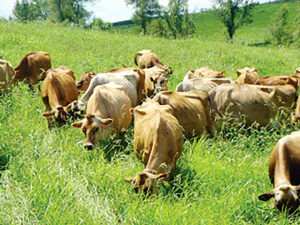
Iowa dairy cows, like these of Radiance Dairy near Fairfield, produce the best and purest organic products.
Revenge of the hayseeds
The brighter side of the hayseed image is that Iowa farmers produce the envy of the world. Hugh Sidey, a Greenfield native who penned a column in Time for 40 years, wrote about John F. Kennedy’s 1960 campaign to be president. After being asked if he liked coming home to Iowa, Sidey said, “Sure, it’s home. You have to understand the prairie.”
Kennedy reflected and replied, “My life is beaches and oceans, but I always remember something Robert Frost said: ‘It’s a shame to grow crops and run them through animals for food.’ Because that black soil looks good enough to eat.”
In 1961, after a meeting with Soviet boss Nikita Khrushchev, Sidey wrote about JFK’s evaluation of the Communist chief.
“Your damned Iowans seem to be about the only people he respects. Nothing seems to bother him except the fear he can’t feed his people. If he ever invaded the U.S., I think he would head straight to Iowa.”
Sidey also wrote about Soviet premieres Leonid Brezhnev and Mikhail Gorbachev taking sudden interest in him after being told that he was from Iowa.
“I know Iowa. I respect and admire what they do,” said Gorbachev who had been Soviet agriculture director earlier in his career.
We still raise crops mainly to feed animals and eat the resulting food. Iowa has been a top two state in corn, egg and hog production for most of two decades. A hundred years ago, we were a national leader in cattle, grapes, apples, peas and squash — crops we don’t feed to animals, or to cars and tractors. We gave that all up after WWII when it became more profitable to plow orchards and gardens and vineyards over to plant soy and corn.
The cattle moved west for cheaper grazing. The chickens and the pigs were moved indoors to industrial plants of filth and cruelty.
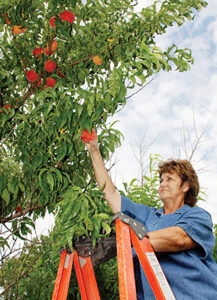
Iowa produces more varieties of apples than anywhere. These are harvested by apple pie queen Diana Sheehy in Audubon County.
History’s designs on Iowa
Iowa is home to more prime farmland than any place on Earth, one-fourth of all of America’s. The state was carved out twixt the nation’s two mightiest rivers and had incredible fertility dumped upon it by glaciers of the last Ice Age. Early farmers marveled that they had found a place where they cleared out more birds’ nests than stones in fields.
The fecundity of that happy accident is not shared statewide. Journalists and politicians who do not perform “the full Grassley” of visiting all 99 counties dismiss us a monotonous stereotype. In reality, the glaciers were kindest to northern Iowa and least kind to southern Iowa.
In the late 1960s, Wiley Maine, who was born in Sanborn and educated at Harvard, proposed in the U.S. House of Representatives that Iowa cede its southern tier of counties to Missouri, “for the purpose of raising the collective IQs of both states.”
The north of Iowa remains more fertile and wealthier than the south, but the whole state has changed utterly since then. In fact, a vast majority of counties peaked in population more than 100 years ago. Modernists argue every year that the 99 counties system is obsolete. It was designed 170 years ago with the purpose of allowing everyone in the state to visit the seat of local government in a one-day ride by horse or buggy. Every year, the modernists are shot down.
That is part of Iowa’s identity. We embrace decentralized power. And we love our 99 courthouses, often still the best examples of architecture in their counties.
Basically, Iowans, more than most others, believe that we are all in it together. In Landis’ words, “Cultural and social factors in Iowa’s communities led to a strong connection to the land, and towns and cities. Rural people relied on shared work. The town celebrations and church potlucks of today are remnants of collaborative networks. I argue that some of the genuineness and decency of Iowa and the Midwest are the legacy of the rural qualities of the region.”
That belief in shared work and civic engagement has influenced much more. Our caucuses and other states secret ballot elections sit in diametrically opposed gymnasium bleachers. Because modern Iowa evolved from farming, there is a strong commitment to good neighboring, not the kind that needs good fences. That was a New England conception, by Frost.
Iowans pitch in when disasters strike a neighbor. And instead of fences, we trust in openness. We need to know how our neighbor voted. Was he with us or against us?
“Iowans are people of civic engagement and commitment. The state remains in the top 10 in voter participation. While Iowa is not without its faults, Iowa historian Jeff Bremer has noted that the state retains a high marriage rate and a low divorce rate,” adds Landis.
When Sidey met TV anchorman Tom Brokaw after the devastating Iowa floods of 1993, he wrote that Brokaw told him: “You would have been proud of your Iowans. They were just magnificent. Helping each other, giving to each other.”
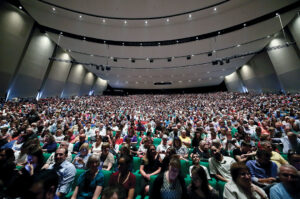
Des Moines Civic Center has no elitist trappings, just a single section with no aisles. Iowans love its democracy.
Iowa architecture
That sense of good neighboring has informed our architecture. Many of Iowa’s building designs incorporate the sensibility that we are all in this together. Kinnick Stadium, Carver Hawkeye Arena, McCleod Center, Des Moines Civic Center, the Iowa State Fairgrounds Grandstand, Elwood Olson Stadium, Drake Stadium, Hoyt Sherman Auditorium, Sheslow Auditorium, and Des Moines Community Playhouse are all designed with no bad seats and no elite seats. Most have single bowls and equitable seating. None have boxes, loges, club rooms, or nose bleed balconies.
When the late Chick Herbert designed the Des Moines Civic Center, he told us its single bowl was a reflection of “Iowa’s strong sense of democracy. No one wants to feel like they are in ‘the cheap seats.’ And few Iowans want to feel elitist either.” Humility is also a part of the state identity.
Herbert’s marvelous auditorium, which almost always ranks first or second in the world in percentage of capacity bookings for an arena its size, also has no aisles dividing seating sections. Just a huge number of doors for remarkably quick exits.
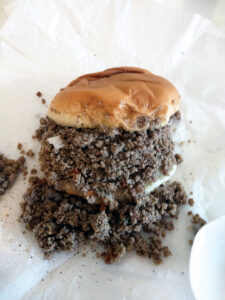
The Maid-Rite is an Iowa invention.
If we are what we eat, what exactly are we?
Food has been Iowa’s big thing since before statehood. What Iowans eat has changed in the last 50 years. Gov. Robert Ray led a charge to bring Southeast Asian refugees to Iowa after the fall of South Vietnam.
That was the beginning of massive immigration from all over the world. When the great food writer Tony Bourdain came to Des Moines, he marveled out loud about the city’s Vietnamese restaurants. Our Latino food scene is just as exciting, with all regions of Mexico and Central America covered.
Iowa now gives the lie to the coastal illusion of the state being composed of boring, white people who force feed each other corn dogs to bulk up. The state has become a magnet for top chefs and restaurateurs. Jay Wang (Wasabi) and Tony He (W Tao) came from New York City, with a score of workers. Miyabi Yamamoto (Miyabi 9) came from Japan via Boston. Jason Demars (R/I) moved from Massachusetts, Sean Wilson (Proof) from North Carolina, David Baruthio (Baru 66) from Strasbourg via Manchester, Marc Navailles (Purveyor, Nomad) from the Basque country via Argentina. Alex Hall (St. Kilda’s, Franka) found his way here from Melbourne via Brooklyn, Gianlucca Baroncini (Baroncini Ristorante) is from Verona via D.C., Andrew Meek (Sage) from Wisconsin, Irina Kharchenko (Irina’s) from Sochi via Los Angeles and Montreal, Baba Singh (India Star) from the Punjab.
I could go on, and that doesn’t even include all the fabulous folks from Southeast Asia and Latin America. Frijoles were just beans for me, till I tried the ambrosia that La Familia serves. Rice flour crepes were unknown to me before Don Cotran (Pho 515) and Kim Anh (Pho All Seasons) served them.
George Formaro, who owns and runs kitchens at six local restaurants, says, “Tony Bourdain said that there would be no French cafés in New York without Pueblo born chefs. Fine dining in Des Moines would be nowhere without chefs from Michoacan and Jalisco.”
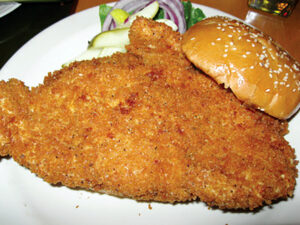
The breaded pork tenderloin was Iowa’s compensation for lack of veal.
Iowa dining is still also based in tradition. Manning, where street signs are in German, moved an historic hausbarn for its German restaurant and Bavarian culture center. Elk Horn built a Danish Museum to celebrate Scandinavian contributions to American dairy. The creators of Johnny and Kay’s, Vic’s Tally Ho, Gino’s, Wimpy’s, La Pizza House, The Latin King, Babe’s, Chuck’s and Noah’s came from Calabria and Emilia Romagna.
There are some 50 organic farms, mostly dairy, within 15 miles of Kalona. Iowa dairy, particularly Radiance, Kalona and Pickett Fences, delivers a taste of the past.
“It drives me crazy when writers and TV hosts rave about Chicago pizza as if it were an island of quality in the Midwest. Des Moines has every bit as much quality and diversity in pizza as Chicago. If there was such a thing as Iowa pizza, it would be tavern style, like Chuck’s, Noah’s and Bordanaro’s,” says Formaro, who imported a Brooklyn coal oven to fire his magnificent pies at Centro.
Most people don’t realize that Iowa’s signature sandwich, the breaded pork tenderloin, also derived from immigration. Czech and Slovaks flocked to Cedar Rapids for packing house jobs in the late 19th century. They craved wiener schnitzel, but veal was scarce. So, they substituted pork. Now it’s celebrated like an icon. Plus, we bread anything we fry in Iowa.
The original Maid Rite, still evidenced at Taylor’s in Marshalltown, was an Iowa invention. The stores all used to incorporate Taylor’s horseshoe shaped counters. Those facilitated community, because everyone is situated to converse with everyone else.
Those sandwiches, which Formaro refuses to call “loose meat,” have histories in Iowa that predate the Depression. In Siouxland, they are called “Charlie boys” or “tastees.” In Ottumwa, they are “canteens.” In Bettendorf, they are called “Rossburgers.” All have a century of history.
Iowa’s true fruit is the apple. We developed some famous breeds (Red Delicious), and our orchards, such as Seed Savers in Decorah, are among the most diverse anywhere. Apples love the climate. Seed Savers has one orchard with more than 100 unique kinds of apple.
So, of course, our cider houses are special. Two (Wilson’s in Iowa City and Fishback and Stephenson in Fairfield) serve some of the best food in the state. Wineries are for weddings in Iowa; cider houses are for anytime.
Sidey, arguably the best writer Iowa ever produced, deserves the last word here. In 1996, he wrote: “No Iowan now lives more than 25 miles from a hospital. There is no high school student who cannot try his hand at basketball or French. No Iowan anywhere is more than 20 miles from the sublime call of the meadowlark.” ♦





















